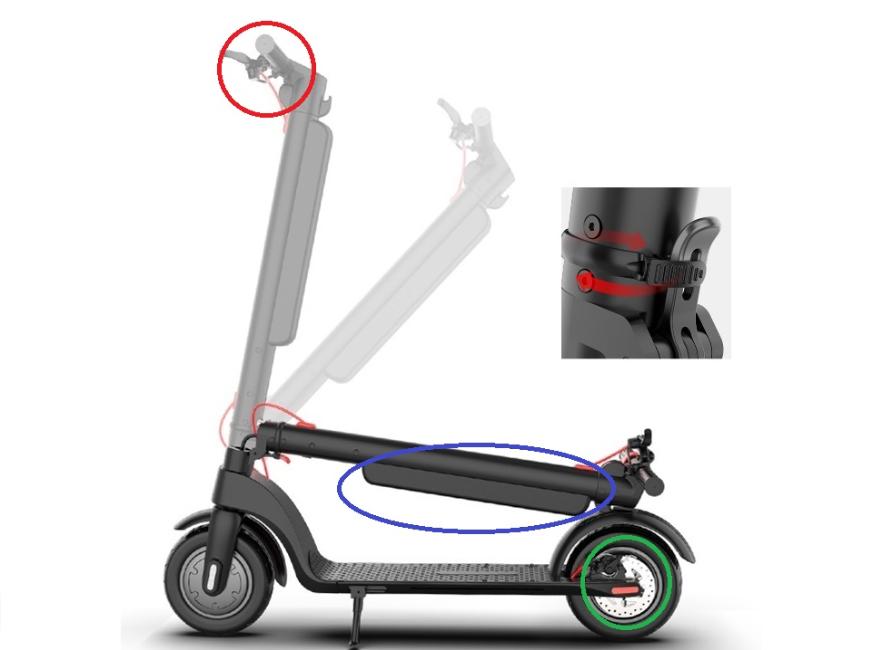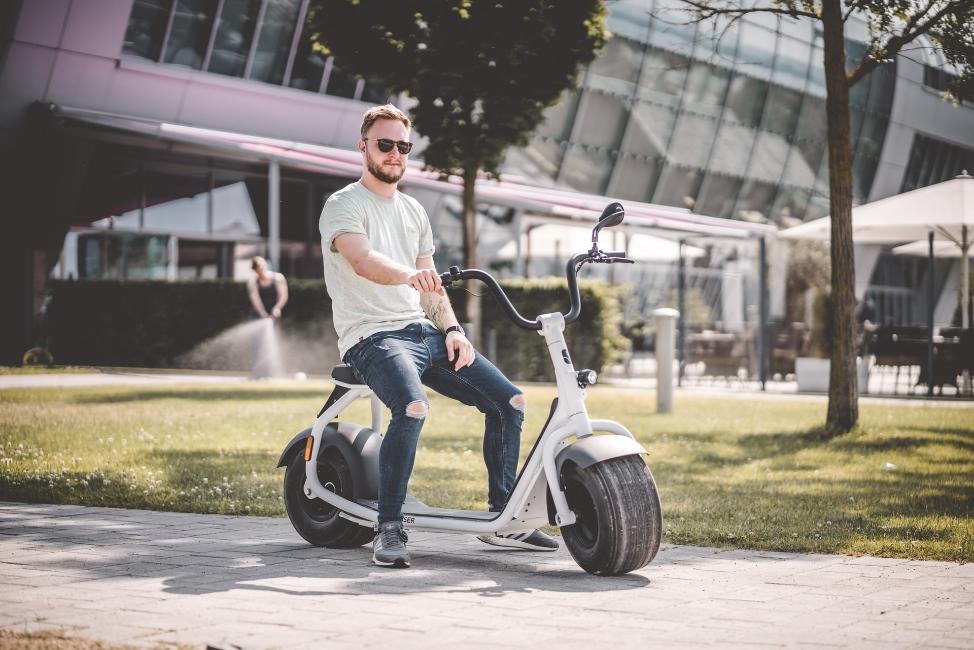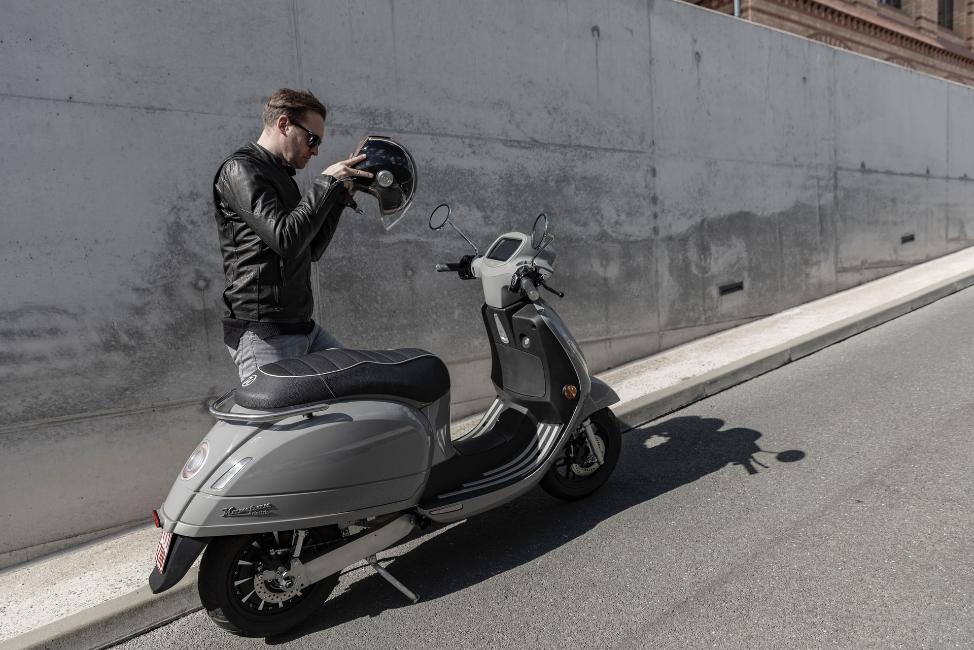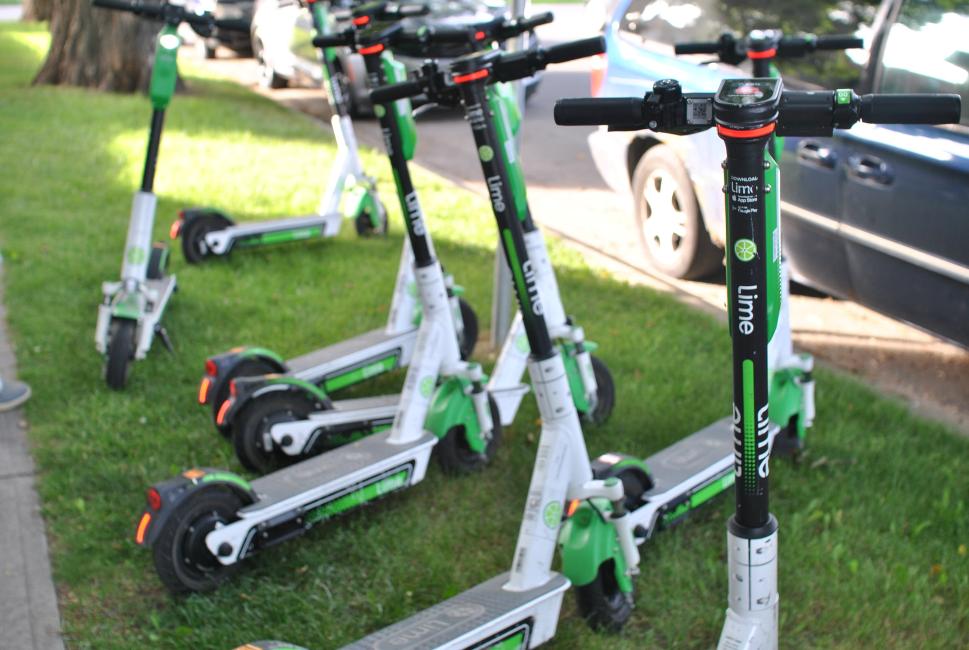Electric vehicles have advanced steadily over the past few years, so much so that they inhabit our daily lives.
In 2020, it’s not uncommon to see e-scooters existing with traditional, human-powered scooters, bicycles, or skateboards.
Dissecting what makes an e-scooter unique from its analog variety doesn’t have to be complicated. In fact, they operate in a similar way to scooters you’ve used as a child. With an added motor, battery, and throttle, you can exceed speeds of 20 mph (32 km/h) easily.
If you’re interested in picking up an electric scooter, this article will act as an introduction.
But first, we need to establish what an e-scooters is before discussing its laws, components, maintenance, and more.
What is an Electric Scooter?
First, let’s look at what makes an electric scooter unique from its traditional human-powered model. To put it plainly, and an electric scooter is a regular scooter with an electrical drive system.
This consists of a battery, motor, and a way to control it. E-scooters, unlike e-bikes, do not have drivetrains because there are no pedals to move the mechanism.
The SmartKick X8 has all the components of a traditional e-scooter:

Photo Courtesy: Kat Dent/Smart Wheel
- Blue Circle: The battery that powers the motor sits on the stem.
- Red Circle: The throttle, which controls the power, is similar to a motorcycle handle.
- Green Circle: Mid-drive motor helps to propel the e-bike forward. Some e-scooters have motors in both wheels, while others have it in one like the scooter pictured.
These three critical components set the e-scooter apart from the human-powered scooter. Once you remove these components, the scooter becomes analog and must be pushed by your legs off of the ground.
What is the Difference Between an E-Scooter and a Motorcycle?
Although there are many similarities between an electric scooter and a motorcycle, they are entirely different from one another. The most significant difference is what powers the motorcycle.
Typically, motorcycles use gas because this fuel offers an unlimited range. Motorcycles can also keep up with highway traffic, and have room for a passenger.
As a disadvantage, motorcycles are more expensive, have loud motors, and are costly to maintain. Motorcycles take up a significant amount of space, as well.
E-scooters cost much less than motorcycles, even when compared to the initial price of the purchase, maintenance, and an expensive battery or motor replacement.
E-scooters are quiet and often fold so small and compact that they can fit in a backpack. You will miss out on the motorcycles’ cool’ factor because scooters are often associated with children’s toys.
If you’re on the market for a lightweight, foldable and compact mode of transportation with no rules or regulations, an e-scooter is the perfect vehicle for you. However, if you want to go faster, drive long distances, and have better visibility and suspension, a motorcycle will suit your needs.
What is the Difference Between an E-Scooter and a Moped?
Electric scooters are often compared to mopeds because of their similar (but bigger) design. Mopeds are gas or electric scooters with a platform for the user’s feet and a step-through base. Some are so big that they are often classified as “power-assisted bicycles” or motorcycles.
Despite how similar they are, mopeds and e-scooter have a few differences that set them apart. First, mopeds are more prominent and clunkier and must be operated on roads or European style wide sidewalks. Mopeds also require a driver’s license, registration, and insurance in most US states, whereas the e-scooter doesn’t.
In the United States, mopeds are made too big and broad to fit on the sidewalks (although some still try to – mopeds aren’t really regulated). E-scooters can function adequately on either the sidewalk or road as long as they’re fast enough to keep up with traffic.
Mopeds and e-scooters can’t ride anywhere but in the city, and both aren’t capable of riding up a mountain with the motor alone. However, an e-scooter is still capable of being carried up a mountain or kicked up if necessary.
How do E-Scooters Work?

Photo Courtesy: Kumpan Electric/Unsplash
Mid-Drive
The electric mid-drive motor in an e-scooter creates an effortless riding experience fro the user. Although mid-drive motors are standard, hub motors are also found in e-scooters, although they don’t perform as well. Mid-drive motors take advantage of the guards to drive the crank and amplify the scooter’s powers.
On an e-scooter, the motor is located in one or more of the wheels, depending on the model. Keeping the motor close to the ground improves the center of gravity, which distributes the weight evenly throughout the scooter.
Battery
Electric scooter battery packs are made up of multiple individual cells that are assembled together. They store the energy that is consumed by the mid-drive or hub motor and other accessories like the lights.
Lithium-ion battery cells are the most common, although some kids’ models will use lead-acid batteries.
Batteries are rated in watt-hours (Wh) to measure capacity, and Wh is an essential factor in determining range. The typical scooter will range from 250-750 watt-hours, which could have a range of 20 mph (32 km/h), 25 mph (40.23 km/h), or 28 mph (45 km/h).
Throttle
Throttles are standard in most electric vehicles, including e-bikes and motorcycles, and they serve the same purpose. When the user turns the accelerator, the motor kicks in and lets you control the speed.
When you turn the throttle forward, the e-scooter will start to drive. The speed of the scooter is determined by how far forward the user turns the throttle.
Along with the accelerator, the brakes, power buttons, speed, and setting displays are also located in various places along the handlebars. Most portable e-scooters have folding handlebars as well, which can help with storage.
Not all e-scooters are made the same, but they all have these 3 components. Most electric scooters came with suspension, brakes, and lights.
How do you Ride an E-Scooter?
Electric scooters operate similarly to many electric vehicles (bikes or skateboards) in that they add a motor to assist propulsion. To ride an electric scooter, simply put your feet on the deck and pull the throttle forward.
Some electric scooters are seated. These are mostly for adults who prefer to make longer rides more comfortable. If your e-scooter doesn’t come with a seat, many can be fitted for one and are sold as a separate accessory.
If the motor runs out, you can push the scooter with your legs on the ground like an analog scooter. Since most batteries are small and detachable, it’s easy to recharge your battery within a few hours – so this is unlikely to occur.
Most e-scooters have either option (to use the throttle or kick manually). This is perfect for office workers who want to arrive at the job without sweating through their clothes. At the same time, an office worker can fold their e-scooter into a backpack or under their desk for easy storage.
Common Features of an E-Scooter

Photo Courtesy: Kenny Luo/Unsplash
Besides the battery, motor, and throttle, many other features come with the typical e-scooter.
Folding
Most electric scooters are able to fold completely in half so you can store them securely in your car, within your home, or on public transport.
If you often take detours in a subway or on an Uber, or you live in a bachelor or small apartment – pick a folding scooter. Folding e-scooters are often lighter, but it’s rare to find a scooter that doesn’t fold, anyway.
Braking System
A quality braking system, such as disc brakes, is essential to stay safe and in control while riding. Brakes can either be electronic or manual, where electric relies on the motor and mechanical relies on a physical mechanism.
Mechanical brakes offer a stronger system, but often e-scooters will use both in case one fails.
Controller
A speed controller sends power to the motor based on individual accelerator input. The controller receives inputs from the accelerator and brake controls and translates this current to the motor. Controllers are rated based on voltage and current to regulate, and they are responsible for most of the power that the e-scooter uses.
Deck
Similar to a skateboard deck, the deck on an e-scooter is the place where yous stand while riding. Rubberized nubs will line the deck for better traction. Some kick scooters will have a wider space for your feet, but a common deck size is usually 14″ by 5″ inches and gives you a few inches for ground clearance.
Stem
The stem is the tube that connects the metal casing to the handlebars. The folding mechanism is usually located on the stem for easy carrying and storage. Before purchasing a scooter, shake the stem back and forth to make sure it doesn’t collapse while riding.
It’s possible for the stem to wobble if the folding mechanism is poorly installed.
Electronic Panel

Photo Courtesy: Kumpan Electric/Unsplash
It’s common for an electric scooter to have a panel display, even though it isn’t necessary for the full experience. Electronic panels will display headlights, distance, power status, speed, PAS grades, and error messages.
A battery level display, included in most electric panels, is beneficial on short-range scooters that could run out of charge quickly.
Range
All e-scooters have a set range based on the batteries wattage. The range depends on the type of riding you’re doing (up a slight hill or city riding), so it’s difficult to put a proper range length as a selling point.
Most manufacturers assume you’ll ride on a flat sidewalk because e-scooters aren’t meant for uphill or mountain riding.
To calculate the watt hours (range) of a battery pack, multiply the voltage by amp hours. A 36-volt 10-Ah battery pack has 360-watt hours (36 X 10 = 360). Each mile costs 20-watt hours on average. Therefore, a 360-watt hour pack will get you 18 miles on one charge.
Suspension
May electric scoots have no suspension, but some expensive models will have coil-over-hydraulic suspension. There are three main suspension systems in an e-scooter: hydraulic, spring, and air piston.
The best suspensions will have a combination of sping and piston, but most scooters will us large pneumatic tires instead.
Tires
Tires help with traction and have internal braking mechanisms that activate in case of an emergency. Airless tires require no air maintenance, but pneumatic tires are better for their traction, ride quality, range, and performance.
If you have purchased a scooter without a decent suspension system, always opt for pneumatic tires.
Common Accessories for an E-Scooter
If you’re thinking about adding some accessories to your e-scooter, consider these items that can improve your safety while also helping you stand out from the crowd.
- Helmet: Safety is no joke – you could be maimed or killed from riding an electric scooter. Since e-scooters exceed 20 mph (32.19 km/h), it’s essential to wear a DOT-approved motorcycle helmet just increase of an accident.
- Side Mirrors: Unless you’ve purchased a $1000 e-scooter, they won’t come with mirrors even though they’re essential for your safety. You can equip a set of mirrors on your handlebars to increase your visibility.
- Lights: Don’t ride at night if you don’t have lights attached to the front and back of your scooter. If your e-scooter comes with front lights, equipt taillights so vehicles can see you in an alleyway or on a dark country road.
- Basket: Although e-scooters are often small, you can equip a deep basket that runs the length of the stem for groceries. Adding a basket helps to remove the likelihood of your back getting sweaty if you wear a backpack during commutes.
We also encourage you to get grips for your handlebars for a more comfortable riding experience. An extra seat may also be ideal for you if you plan on taking long trips. Always buy scooter tools for standard repair and maintenance jobs.
Growing Popularity of E-Scooters

Photo Courtesy: Nick Belanger/Unsplash
According to the Global E-Scooter Market projections for 2020-2024, the growth rate is expected to increase by 5.94% each year. On average, the e-scooter market is expected to grow by 2,138.50 thousand units in the next 4 years.
This is attributed to the increase in pollution and traffic congestion that is driving consumers to choose electric transportation.
The development of high-performance e-scooters is one of the reasons why market trends are seeing a growth in the market.
The decline in battery prices, increasing awareness of the technology, and the low operating cost make e-scooters affordable to many Americans, and many large retailers like Suzuki Motor are taking notice of this trend.
A senior analyst at Technavio stated: “Factors such as the emergence of connected e-scooters and established two-wheeler OEMs venturing into global electric two-wheeler market will have a significant impact on the growth of the e-scooter market value during the forecast period,”
Technavio, a global technology research and advisory company, researches emerging marketing trends. They assume that e-scooters will be on the rise indefinitely.
Laws and Regulations
E-scooters aren’t as regulated as other electric vehicles (like the e-bike), but in general, they are considered illegal in all US states. Most jurisdictions regulate them like bicycles, as they can be ridden on the street or bike lanes.
Since there are very few regulations associated with e-scooters, it’s better to review individual state laws before operating. You will not need a license or any special insurance to ride an e-scooter, although coverage is available if needed. Be sure to follow and obey all traffic laws, like stopping at a red light or turning left on a green light.
Speed and Kicking
The speed of an e-scooter depends mostly on price rather than other factors such as Class on an e-bike. Most e-scooters will range from 20 mph (32.19 km/h) to 28 mph (45 km/h). Anything faster isn’t considered illegal because e-scooters aren’t as regulated.
| Battery + Motor (Flat Terrain 165 lbs Male) | Max Speed | Average E-Scooter Cost | Average Charge Time |
| 250w | 20 mph (32.19 km/h) | $500 – $1000 | 20 minutes |
| 500w | 25 mph (40.23 km/h) | $750 – $1250 | 40 minutes |
| 750w | 28 mph (45 km/h) | $750 – $1500 | 60 minutes |
| 1000w | 35 mph (56.32 km/h) | $1000 – $1500 | 80 minutes |
| 1500w | 40 mph (64 km/h) | $1500 – $2000+ | 120 minutes |
E-scooters have the option of turning into kick scooters, but they won’t provide any extra speed. In fact, they will slow down your e-scooter and/or case the braking mechanism to kick in for safety reasons. It’s better just to use the throttle.
Safety Tips
E-scooters provide a great way to get around the city. Although they are considered relatively safe, e-scooters require attention to ensure your commute doesn’t become dangerous. Many electric scooter safety tips apply to traditional scooters, bicycles, and other motorized vehicles.
- Wear A Proper Helmet
- Use Both the Tailights and Headlights
- Use a Bell or Horn to Warn Others
- Never Ride Against Traffic
- Avoid Sidewalks if Possible
- Keep Pneumatic Tires From Deflating
- Use Defensive Driving Techniques
- Install and Use Your Mirrors
Even though scooters aren’t regulated or require a license to operate, it’s never okay to drive drunk. It’s possible to get seriously injured if you aren’t aware of your actions. Instead, fold your e-scooter, place it in an Uber, or walk home.
Insurance
Property insurance (renter or homeowner condo insurance) usually includes liability protection. This means that if someone gets hurt, or has their property damaged or destroyed in an accident, that liability insurance should help cover your expenses.
This can also include damages defense costs settlement and judgment awards.
You must report any damage you see on your e-scooter to the insurance company, as the manufacture will usually cover general wear and tear. However, if the cost goes beyond the damage of your scooter, you likely won’t be covered by insurance.
Most insurance won’t cover medical expenses, but your health care provider will likely supplement that cost. Liability coverage in your home and auto insurance is tailored towards injuries to others, so insurance won’t cover you in this situation.
Although insurance does exist, it’s a lot more prevalent in Europe and Canada than it is in the United States. You may have to get bicycle insurance that includes other motor vehicles. To see what in-depth coverage looks like, visit this insurance company based out of Alberta, Canada.
Average Lifespan

Photo Courtesy: Zera Li/Unsplash
Privety-owned e-scooters with proper maintenance and care will last at least 2-3 years, and likely much longer than that. Rideshare electric scooters will only last 1-5 months, but that is likely due to the mistreatment of the device itself.
If you treat your e-scooter correctly, you could see 7 years or longer.
Privately-owned e-scooters aren’t often dumped, so people likely continue to fix them for as long as possible. Individual parts that tend to break are the battery, front and rear lights, tires, and the rear fender.
If you focus your time on maintaining these parts, you’ll likely have an e-scooter that lasts a very long time.
Maintenance
Schedule A Weekly Cleaning: Keep your e-scooter clean as often as possible to dirt, debris, and dust don’t make their way into the engine. Never use a pressurized hose or stream of water because it could expose liquid into the electrical system.
Lubrication: You should lube the rolling mechanism every 3 months. The specific timeframe for lubing and greasing depends on your riding conditions. The more water and dirt your e-scooter is exposed to, the sooner you’ll need to grease it.
Tire Pressure: Whether your e-scooter comes with air-filled or solid rubber tires, you need to ensure there are no cuts or scrapes on the surface. Flat tires are common, so pump them full of air every week to keep a smooth ride long-term.
Check the Bolts: Be sure to tighten the nuts and bolts every two months or so. Use your fingers to see how tight or loose the nuts are, and if they come apart with your own strength, it’s crucial to tight them immediately for your safety.
Battery: Lithium-ion batteries are pretty durable, so there isn’t a lot you need to do to maintain them. Do your best to keep water out of them and store them at room temperature to ensure they function correctly.
Brakes: Before you ride your e-scooter, it’s important to pump the brakes to ensure they function. Otherwise, you could end up in a serious accident. If you notice they aren’t working properly, brake pads are cheap and easy to replace.
Storage Tips: Keep your e-scooter indoors wherever possible. E-scooters don’t do well in high temperatures or water, but they can handle a small drizzle or occasional direct sunlight. Always remove the battery and motor during prolonged storage.
Are you an e-scooter enthusiast?
Are you interested in many other articles, like this one, that gives in-depth information about different e-scooters?
Visit our website for more information on the best electric bikes and scooters that can make your commute more stylish and fun.
Before you go, leave a comment on your favorite e-scooter maintenance tips.
Be sure to read one of our other articles about the history of bicycles and e-bikes while you’re at it!


